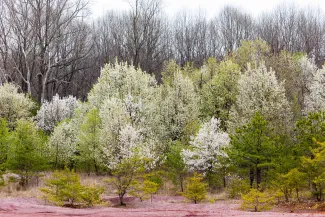The callery pear, Pryus calleryana, was brought to the U.S. in the late 1800s in an attempt to fight the fire blight of the common pear. Callery pear has many cultivars but the two most common in Oklahoma are the Bradford pear and Chanticleer pear. The tree species has been widely used as an ornamental due to the showy white flowers in the spring and vibrant red foliage in the fall.
The problems with the callery pear arise due to its rapid growth rate and the invasive properties of its seeds. The callery pear seeds are consumed and easily dispersed by birds into open areas such as pastures and native grasslands. The rapid growth allows the plant to form dense thickets which shade out the native vegetation. Due to its ability to invade and outcompete native plants, the callery pear is a significant threat to native grasslands and grassland wildlife. It also poses a threat in forested areas where it grows in the understory and competes with native trees for water, minerals, and space.

Control:
Callery pear is a vigorous resprouter and prolific seeder; therefore, control methods include mechanical and herbicidal treatments to completely eradicate the species from a site. After treatments have been applied and callery pears have been removed from the property the landowner will need to monitor for any new seedlings that may sprout up for the next several years.
Pear saplings can be removed by hand when the soil is moist, taking care to remove the entire root system. For trees with a trunk less than 6 inches in diameter, a basal bark method can be utilized with the use of a spray bottle or backpack sprayer. Using an herbicide solution of 25 percent triclopyr and 75 percent crop oil, spray the base of the tree trunk (at ground level) up to approximately 12 inches making sure to coat the entire circumference of the trunk. The most effective timeframe for this treatment is late winter/early spring or during the summer.
Mature trees can be girdled in the spring and summer or cut down and then sprayed with herbicide to prevent resprouting. To girdle mature trees, make a cut through the bark and around the entire circumference of the trunk at 6 inches above the ground. If using the cut-stump method, spray the stump within 15 minutes after cutting down the tree with a mixture of 25 percent triclopyr and 75 percent water or undiluted glyphosate.
Alternative Plants:
If replanting of trees is wanted or needed, there are many native trees that make great alternatives to callery pear. The following trees are a few that are commercially available, beautiful, and native to Oklahoma: redbud, Cercis canadensis, flowering dogwood, Cornus florida, black gum, Nyssa sylvatica, serviceberry, Amelanchier arborea, and American plum, Prunus americana.